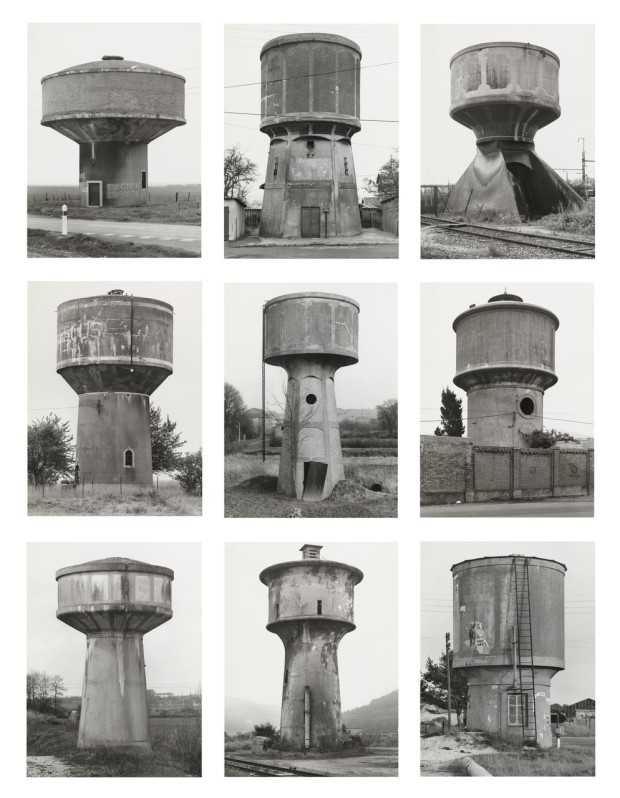An iconographic and text archive related to communication, technology and art.
☛ Water Towers: “11. Neunkirchen, Saarland, D 1979” by Bernd Becher and Hilla Becher, Cambridge: MIT Press, 1988.
German photographer Hilla Becher died on Saturday, October 10, in Düsseldorf. Her husband, Bernd Becher, died in 2007. They are renowned for the systematic documentation of industrial architecture they produced together since the late 1950s. This systematic approach evokes a methodology in-between that of taxonomists and of structuralists. Here’s how Hilla Becher explained it an interview she gave in 2002:
The serial element for us resulted from our having collected so much material on certain topics. But our idea of showing the material has much more to do with the 19th century, with the encyclopedic approach used in botany or zoology, where plants of the same variety or animals of the same species are compared with one another on the individual pages of the lexicon. It became more and more clear to us that there are definite varieties, species and subspecies of the structures we were photographing. That is, in effect, an old-fashioned approach. Later it was also used in Conceptual art, logically enough. (“The Bechers’ Industrial Lexicon”, see below for the complete reference).
Other photographers have proposed a visual classification of natural forms. It is the case for example the work of Karl Blossfeldt. The Becher gave all their attention instead to the artificial structures of modern, heavy industry. Hilla was nonetheless very fond of those structures, calling them “creatures” (creatura), as she does in the Contacts episode referenced at the end of this post.

In 1988, Water Towers became the first of their monographs to be published in the United-States. The introduction they offer to this particular collection is succinct, almost clinical:
The tower is a part of the complexe system by which water is collected and distributed. Consisting of a water tank and a towerlike substructure, it fulfills two purposes at the same time: storage and the maintenance of pressure.
How tall a water tower must be depends on how far the water it stores must be delivered. The size of the tank is determined by the amount of water that must be made available at times of peak demand, by daily variations in consumption, and by consideration of emergencies such as fires and pump failures.
After each drop in the water level, a simple regulation mechanism (a float) activates the pump. The tank is then filled via the inflow pipe. Another pipe carries water in, and an overflow pipe prevents overfilling. The »lantern« a plate-covered opening in the uppermost part of the tank, allows the proper amount of air to enter or exit as the water level decreases or increases.
The tank may be constructed of wood, steel, or reinforced concrete. The base may be a massive piece of stonework or an open structure of steel, concrete, or wood. Newer methods of construction employ a single tubular column or a ring of pipes for the base. Large water towers have staircases in their substructures: smaller ones may have ladders instead. The inside of the tank is accessible for cleaning and for repair work. (“Functional Aspects of Water Towers”, in Water Towers, 2002, p. 13).

For more about the Becher, consider the following resources:
-
The New York Times: “Hilla Becher, Photographer Who Chronicled Industrial Scenery, Dies at 81” by Swell Chan, Oct. 14, 2015.
-
The Guardian: “How Hilla Becher found beauty and dignity in industrial decline” by Sean O’Hagan, October 15, 2015.
-
The J. Paul Getty Museum has 128 photos available online.
-
Sonnabend Gallery has 46 items available online, all properly identified.
-
The MOMA has 15 works available online.
-
Art in America: “The Bechers’ Industrial Lexicon” by Ulf Erdmann Ziegler, June 2002, no. 6, pp. 93-101, 140-143.
-
Sign and Sight: “High precision industrial age souvenirs” interview with Cornelius Tittel, September 2005.
-
Tate Papers no. 1: “The Photographic Comportment of Bernd and Hilla Becher”, Blake Stimson, Spring 2004.
-
Tate Magazine no. 1: “The long look” by Michael Collins, October 1st, 2002.
-
Parachute: “Photographing Industrial Architecture: An Interview with Hilla and Bernd Becher” by Angela Grauerholz and Anne Ramsden, no. 22, 1981, pp. 14-19.
-
In 2002, ARTE produced a 15-min episode about the work of Bernd and Hilla Becher as part of the award-winning Contacts documentary series. The episode is included in the third volume of the series, which is about conceptual photography. At the time of writing, the episode is available on YouTube in two parts: Part I, Part II. A higher resolution (720p) is also available with Spanish subtitles here.
- By Philippe Theophanidis
- on
- ― Published in Architecture, Art, Photography, Technology
- Tagged: Becher, classification, obituary, taxonomy, tower, typology, water

